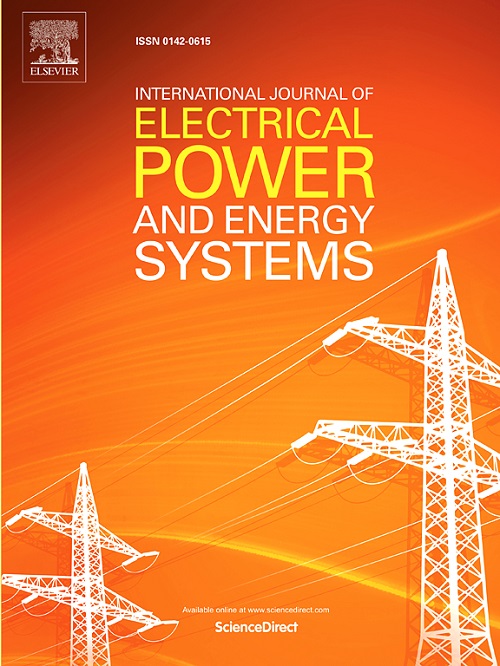利用 Harris Hawks 优化法(HHO)优化独立风力-光伏-柴油-电池系统的规模:伊朗布什尔一个码头的案例研究
IF 5
2区 工程技术
Q1 ENGINEERING, ELECTRICAL & ELECTRONIC
International Journal of Electrical Power & Energy Systems
Pub Date : 2024-11-06
DOI:10.1016/j.ijepes.2024.110353
引用次数: 0
摘要
随着全球能源需求的增长,可再生能源作为一种潜在的解决方案日益受到关注。本研究考虑了风力涡轮机 (WT)、光伏 (PV)、柴油发电机 (DG) 和电池 (Bat) 的各种配置,考察了优化离网混合多资源系统的年度总成本。研究以伊朗布歇赫尔的一个石油码头为案例。优化过程采用 Harris Hawk Optimization (HHO) 算法,这是一种受自然启发、基于群体的优化技术,在本文中首次用于混合配置和优化尺寸。该算法的性能与传统优化方法进行了比较,以评估其效率。研究方法包括:(1)解释每种能源的经济关系;(2)制定成本函数;(3)使用 HHO 算法最小化基于可再生能源的混合系统的总成本。HHO 算法的灵感来自哈里斯鹰的狩猎行为,特别是它们的 "奇袭 "策略。这种新颖的优化方法旨在为给定场景找到最具成本效益的能源配置。研究的主要发现包括:与粒子群优化(PSO)和灰狼优化器(GWO)相比,HHO 算法在所有测试配置中都表现出更高的效率。最具成本效益的配置是光伏、电池和柴油发电机的组合。在所有测试的配置中,该配置的年总成本最低。最佳系统由 450 个光伏单元、9 个电池单元和 2 个柴油发电机单元组成,最低年成本约为 355525 美元。这些结果凸显了 HHO 算法在优化可再生能源系统方面的潜力,并证明了混合能源配置中成本与环境影响之间的复杂权衡。这项研究为可再生能源系统设计和优化领域,特别是工业环境中的离网应用,提供了宝贵的见解。本文章由计算机程序翻译,如有差异,请以英文原文为准。
Size optimization of standalone wind-photovoltaics-diesel-battery systems by Harris hawks optimization (HHO): Case study of a wharf located in Bushehr, Iran
The global increase in energy demand has led to a growing focus on renewable energy sources as a potential solution. This study examines the annual total cost of optimized off-grid hybrid multi-resource systems, considering various configurations of Wind Turbines (WT), Photovoltaics (PV), Diesel Generators (DG), and Batteries (Bat). The research focuses on an oil dock in Bushehr, Iran, as a case study. The optimization process employs the Harris Hawk Optimization (HHO) algorithm – which is used for the first time for hybrid configuration and optimal sizing in this paper-, a nature-inspired, population-based optimization technique. This algorithm’s performance is compared to conventional optimization methods to assess its efficiency. The study’s methodology involves: (1) Explaining the economic relationships for each energy source, (2) Formulating a cost function, (3) Using the HHO algorithm to minimize the total cost of the renewable energy-based hybrid systems. The HHO algorithm is inspired by the hunting behavior of Harris hawks, specifically their “wonder attack” strategy. This novel approach to optimization aims to find the most cost-effective configuration of energy sources for the given scenario. Key findings of the study include the HHO algorithm demonstrated superior efficiency compared to Particle Swarm Optimization (PSO) and Gray Wolf Optimizer (GWO) across all configurations tested. The most cost-effective configuration was found to be a combination of photovoltaics, batteries, and diesel generators. This setup had the lowest total annual cost among all configurations examined. The optimal system consisted of 450 photovoltaic units, 9 battery units, and 2 diesel generator units, with a minimum annual cost of approximately $355,525. These results highlight the potential of the HHO algorithm in optimizing renewable energy systems and demonstrate the complex trade-offs between cost and environmental impact in hybrid energy configurations. The study contributes valuable insights to the field of renewable energy system design and optimization, particularly for off-grid applications in industrial settings.
求助全文
通过发布文献求助,成功后即可免费获取论文全文。
去求助
来源期刊
CiteScore
12.10
自引率
17.30%
发文量
1022
审稿时长
51 days
期刊介绍:
The journal covers theoretical developments in electrical power and energy systems and their applications. The coverage embraces: generation and network planning; reliability; long and short term operation; expert systems; neural networks; object oriented systems; system control centres; database and information systems; stock and parameter estimation; system security and adequacy; network theory, modelling and computation; small and large system dynamics; dynamic model identification; on-line control including load and switching control; protection; distribution systems; energy economics; impact of non-conventional systems; and man-machine interfaces.
As well as original research papers, the journal publishes short contributions, book reviews and conference reports. All papers are peer-reviewed by at least two referees.

 求助内容:
求助内容: 应助结果提醒方式:
应助结果提醒方式:


